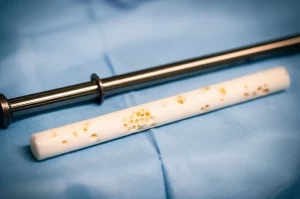Root Canal Treatment for Seniors: Faster, Easier, and Just as Effective?
Okay, let’s talk teeth! Specifically, root canals. Now, for many of us, just the phrase “root canal” might send a little shiver down the spine. But for older patients, there can be even more considerations. As we get a little wiser (and maybe our teeth get a little more… *experienced*), things like calcification in the canals, existing health conditions, and even just the sheer length of a dental appointment can make treatment a bit trickier.
Because of these unique challenges, sometimes older folks end up losing a tooth instead of getting the root canal treatment that could save it. It’s a shame, really, because saving your natural teeth is almost always the best option for long-term health and comfort. The good news? Dental science is always looking for better ways to do things, especially for different groups of patients.
That’s where this fascinating study I stumbled upon comes in. It dives deep into how different materials and techniques work for root canals specifically in patients aged 60 and over. They were testing a relatively new material called C-Root SP, which is a type of bioceramic sealer, against a more established one (iRoot SP) and trying out a few different ways of filling the root canal after it’s been cleaned out.
The Big Question
The main goal was to see if C-Root SP, combined with different filling methods, could offer good results for older patients. Could it be faster? Less painful? Just as successful in the long run as what’s considered a standard approach?
Think of a root canal like cleaning out a tiny, intricate tunnel system inside your tooth and then sealing it up perfectly. The “sealer” is like the glue, and the “obturation technique” is the method you use to pack everything in there. Getting that seal just right is super important to prevent future problems.
Bioceramic sealers like C-Root SP are pretty cool because they’re designed to be really friendly to the body’s tissues. They can actually encourage healing and form a tight seal. C-Root SP is particularly interesting because it uses strontium, which is known for helping with bone repair and might even have pain-relieving properties. Intriguing, right?
Setting Up the Study
So, how did they figure this out? They gathered 240 patients, all 60 or older, who needed a root canal. They split them randomly into four groups:
- Group A: Used C-Root SP sealer with the Single-Cone (SC) technique.
- Group B: Used C-Root SP sealer with the Warm Vertical Compaction (WVC) technique.
- Group C: Used C-Root SP sealer with the Cold Lateral Condensation (CLC) technique.
- Group D: Used iRoot SP sealer with the Single-Cone (SC) technique (this was the control group).
They prepared the root canals carefully, put in some temporary medication, and then 7-10 days later, they did the final filling using the assigned method for each group. They kept track of a few key things:
- How long the filling procedure took.
- How well the filling reached the end of the root (checked with X-rays).
- How much pain patients reported on days 1, 2, and 7 after the procedure.
- The overall success of the treatment after 1 year, looking at symptoms and using a special score (called the PAI score) from X-rays to see if the infection around the root had healed.
It was a “single-blind” study, meaning the patients didn’t know which group they were in, but the dentists doing the work did (that part’s hard to blind!). They also had independent experts look at the X-rays without knowing which group was which, which helps keep things objective.

Speed Matters!
One of the first things they looked at was how long it took to do the filling part. And here’s where the Single-Cone (SC) technique really shone. Both Group A (C-Root SP + SC) and Group D (iRoot SP + SC) were significantly faster at getting the job done compared to Groups B (C-Root SP + WVC) and C (C-Root SP + CLC). There wasn’t much difference in speed between the Warm Vertical Compaction and Cold Lateral Condensation methods, or between the two different sealers when using the same technique.
Why is speed important, especially for older patients? Well, sitting in the dental chair for a long time can be tiring! A quicker procedure can mean less fatigue and a more comfortable experience overall. So, the SC technique definitely has an advantage on the efficiency front.
Getting the Filling Length Just Right
Next up, they checked the X-rays right after the filling to see if it went to the right spot in the root canal. Getting the length correct is crucial for success. If it’s too short, it might not seal properly; if it’s too long, the material can irritate the tissue beyond the tooth.
The good news here is that all the groups did pretty well. Most fillings were in the “proper” range (within 0-2mm of the tip). While Group A (C-Root SP + SC) had a slightly higher rate of proper fillings and lower rates of over- or under-filling, the differences weren’t statistically significant across the groups. So, when it comes to getting the filling to the right length, all these combinations seemed comparable.
Tackling That Post-Op Ouch!
Nobody likes pain, especially after a dental procedure. The study asked patients to rate their pain level on a scale from 0 to 10 on days 1, 2, and 7 after the filling. As you’d hope, pain generally decreased over time in all groups.
Here’s where Group A (C-Root SP + SC) had a notable win: On Day 1, they reported significantly lower pain rates compared to *all* the other groups. By days 2 and 7, the differences weren’t significant anymore, but that initial reduction in discomfort is a big deal! This finding partially challenges the idea that there’s no difference in pain between the groups.
The researchers speculated that the strontium in C-Root SP might play a role here, given that strontium compounds have been shown to help with pain in other medical contexts. It’s an exciting possibility!

The Long Game: Success After a Year
Ultimately, the real test of a root canal is whether it heals the infection and keeps the tooth healthy long-term. The study followed up with patients after a year to check for symptoms and look at those PAI scores on the X-rays (a lower score means better healing).
And the results? Fantastic across the board! All four groups showed a significant reduction in their PAI scores, meaning the periapical lesions (infections at the root tip) were healing nicely. The success rates were also very high, ranging from about 91% to almost 95%. Crucially, there were *no significant differences* in success rates or the amount of PAI score reduction between any of the groups after one year.
This is a really important finding. It tells us that while the techniques and sealers might differ in terms of speed and initial comfort, they all seem to achieve similar, excellent healing outcomes for older patients after a year. The null hypothesis (that there’s no difference in success rate or PAI changes) was accepted.
What Does This All Mean?
So, what’s the takeaway from all this? Well, for older patients needing root canal treatment, this study offers some great insights:
- Modern root canal treatment, using these bioceramic sealers and techniques, has a very high success rate, even with the challenges that come with age. Age itself isn’t a barrier to successful treatment!
- The Single-Cone (SC) technique is a winner for efficiency. It’s significantly faster, which can make the whole experience much easier for the patient.
- Combining C-Root SP with the SC technique showed a promising advantage in reducing pain, particularly in the first day after the procedure. This could be a big plus for patient comfort.
- In the long run (at least based on the 1-year results), all the tested combinations of C-Root SP with different techniques, and even the control group using iRoot SP with SC, resulted in similar, high success rates and good healing.
This suggests that dentists treating older patients have good options. If speed and potentially less early pain are top priorities, the C-Root SP + SC combo looks particularly appealing based on these findings. But rest assured, the other techniques and sealers tested also lead to successful healing.

Looking Ahead
Of course, like any good study, this one had its limitations. It was done at a single center, the sample size, while decent, could always be larger, and they only followed patients for one year. Root canal outcomes are often assessed over much longer periods. The researchers themselves noted the need for more extensive, multicenter trials with longer follow-up times to really solidify these findings.
But for now, this is definitely encouraging news. It highlights that with the right materials and techniques, saving teeth with root canals is a very viable and successful option for older individuals, potentially with added benefits like faster procedures and reduced initial discomfort.
It just goes to show, dental science keeps moving forward, finding ways to make treatments better and more comfortable for everyone, no matter their age!

Source: Springer







